| Tornado | Speed (mph) | KE (Joules) | KE (Tons of TNT) | Tier |
|---|---|---|---|---|
| F0 | 40–72 | 1.0163497046901e10 - 3.2929730431958e10 | 2.42913409342758113 - 7.87039446270506726 | High 8-C |
| F1 | 73–112 | 3.3850797351834e10 - 7.9681816847702e10 | 8.09053473992208438 - 19.0444112924717963 | High 8-C+ to 8-B |
| F2 | 113–157 | 8.1111058619922e10 - 1.5657502419316e11 | 19.3860082743599413 - 37.4223289180592715 | 8-B |
| F3 | 158–206 | 1.5857596267427e11 - 2.6956135042642e11 | 37.9005646927031492 - 64.4267089929302159 | 8-B |
| F4 | 207–260 | 2.7218480310166e11 - 4.2940775023156e11 | 65.0537292307982824 - 102.630915447313569 | 8-B+ to 8-A |
| F5 | 261–318 | 4.3271723895745e11 - 6.4235842210674e11 | 103.421902236484229 - 153.527347539851803 | 8-A |
The official discord link if you wish to join the discord: https://discord.gg/j5RKwCvAFu
Support the wiki on our official Ko-Fi page or Patreon page!
User:GiverOfThePeace/Tornado Calculation Chart
Introduction
This will be handling tornado calculations since they're frequent in fiction, this will also be added to the Reference for Common Feats page. The calculations will use both the Old Fujita Scale (as some older fictions use this) and the Enhanced Fujita Scale. Though for the Tornado page, only the Enhanced Fujita scale will be noted.
Fujita Scale
| Scale | Wind speed estimate[1] | Frequency[2] | Potential damage | ||
| mph | km/h | ||||
| F0 | 40–72 | 64–116 | 44.14% | Light damage. Small trees are blown down and bushes are uprooted. Shingles are ripped off roofs, windows in cars and buildings are blown out, medium to large branches snapped off of large trees, sheds are majorly damaged, and loose small items are tossed and blown away (i.e. lawn chairs, plastic tables, sports equipment, mattresses). Barns are damaged. | 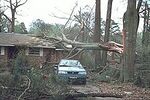
|
| F1 | 73–112 | 117–180 | 34.24% | Moderate damage. Roofs stripped from shingles or planting. Small areas of roof may be blown off house. Doors and garage doors blown in, siding ripped off houses, mobile homes flipped or rolled onto their sides, small trees uprooted, large trees snapped or blown down, telephone poles snapped, outhouses and sheds blown away. Cars occasionally flipped or blown over, and moderate roof and side damage to barns. Corn stalks slightly bent and stripped of leaves. | 
|
| F2 | 113–157 | 181–253 | 16.17% | Significant damage. Whole roofs ripped off frame houses, interiors of frame homes damaged, small and medium trees uprooted. Weak structures such as garages, barns, and mobile homes are completely destroyed. | 
|
| F3 | 158–206 | 254–332 | 4.35% | Severe damage. Roofs and numerous outside walls blown away from frame homes, all trees in its path uprooted and/or lofted, two-story homes have their second floor destroyed, highrises have many windows blown out, radio towers blown down, metal buildings (i.e. factories, power plants, and construction sites) are heavily damaged, sometimes completely destroyed. Large vehicles such as tractors, buses, and forklifts are blown from their original positions. | 
|
| F4 | 207–260 | 333–418 | 1.00% | Devastating damage. Trees partially debarked, cars are mangled and thrown in the air, frame homes are completely destroyed and some may be swept away, moving trains blown off railroad tracks, and barns are leveled. | 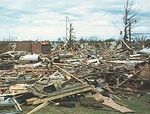
|
| F5 | 261–318 | 419–512 | 0.10% | Incredible damage. Cars are mangled and thrown hundreds, possibly thousands of yards away. Frame homes, brick homes, and small businesses are swept away, trees debarked, corn stalks flattened or ripped out of the ground, skyscrapers sustain major structural damage, grass ripped out of the ground. Wood and any small solid material become dangerous projectiles. | 
|
Enhanced Fujita Scale
| Scale | Wind speed estimate[3] | Frequency[4] | Potential damage[5] | Example of damage | |
|---|---|---|---|---|---|
| mph | km/h | ||||
| EFU | N/A | N/A | 3.11% | No surveyable damage. Intensity cannot be determined due to a lack of information. This rating applies to tornadoes that traverse areas with no damage indicators, cause damage in an area that cannot be accessed by a survey, or cause damage which cannot be differentiated from that of another tornado. | N/A |
| EF0 | 65–85 | 105–137 | 52.82% | Minor damage. Small trees are blown down and bushes are uprooted. Shingles are ripped off roofs, windows in cars and buildings are blown out, medium to large branches snapped off of large trees, sheds are majorly damaged, and loose small items are tossed and blown away (i.e. lawn chairs, plastic tables, sports equipment, mattresses). Barns are damaged.[6] | 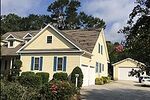
|
| EF1 | 86–110 | 138–177 | 32.98% | Moderate damage. Roofs stripped from shingles or planting. Small areas of roof may be blown off house. Doors and garage doors blown in, siding ripped off houses, mobile homes flipped or rolled onto their sides, small trees uprooted, large trees snapped or blown down, telephone poles snapped, outhouses and sheds blown away. Cars occasionally flipped or blown over, and moderate roof and side damage to barns. Corn stalks slightly bent and stripped of leaves. | 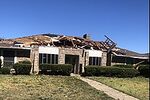
|
| EF2 | 111–135 | 178–217 | 8.41% | Considerable damage. Whole roofs ripped off frame houses, interiors of frame homes damaged, small and medium trees uprooted. Weak structures such as barns and mobile homes are completely destroyed. | 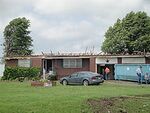
|
| EF3 | 136–165 | 218–266 | 2.18% | Severe damage. Roofs and numerous outside walls blown away from frame homes, all trees in its path uprooted or lofted. Two-story homes have their second floor destroyed, high-rises have many windows blown out, radio towers blown down, metal buildings (i.e. factories, power plants, and construction sites) are heavily damaged, sometimes completely destroyed. Large vehicles such as tractors, buses, and forklifts are blown from their original positions. | 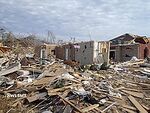
|
| EF4 | 166–200 | 267–322 | 0.46% | Devastating damage. Trees partially debarked, cars are mangled and thrown in the air, frame homes are completely destroyed and some may be swept away, moving trains blown off railroad tracks, and barns are leveled. | 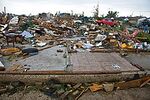
|
| EF5 | >200 | >322 | 0.05% | Incredible damage. Cars are mangled and thrown hundreds, possibly thousands of yards away. Frame homes, brick homes, and small businesses, are swept away, trees debarked, corn stalks flattened or ripped out of the ground, skyscrapers sustain major structural damage, grass ripped out of the ground. Wood and any small solid material become dangerous projectiles. | 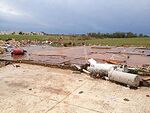
|
Damage indicators and degrees of damage
The EF scale currently has 28 damage indicators (DI), or types of structures and vegetation, each with a varying number of degrees of damage (DoD). Each structure has a maximum DoD value, which is given by total destruction. Lesser damage to a structure will yield lower DoD values.[7] The links in the right column of the following table describe the degrees of damage for the damage indicators listed in each row.
| DI No. | Damage indicator (DI) | Maximum degrees of damage |
|---|---|---|
| 1 | Small barns or farm outbuildings (SBO) | 8 |
| 2 | One- or two-family residences (FR12) | 10 |
| 3 | Manufactured home – single wide (MHSW) | 9 |
| 4 | Manufactured home – double wide (MHDW) | 12 |
| 5 | Apartments, condos, townhouses [three stories or less] (ACT) | 6 |
| 6 | Motel (M) | 10 |
| 7 | Masonry apartment or motel building (MAM) | 7 |
| 8 | Small retail building [fast-food restaurants] (SRB) | 8 |
| 9 | Small professional building [doctor's office, branch banks] (SPB) | 9 |
| 10 | Strip mall (SM) | 9 |
| 11 | Large shopping mall (LSM) | 9 |
| 12 | Large, isolated retail building [K-Mart, Wal-Mart] (LIRB) | 7 |
| 13 | Automobile showroom (ASR) | 8 |
| 14 | Automobile service building (ASB) | 8 |
| 15 | Elementary school [single-story; interior or exterior hallways] (ES) | 10 |
| 16 | Junior or senior high school (JHSH) | 11 |
| 17 | Low-rise building [1–4 stories] (LRB) | 7 |
| 18 | Mid-rise building [5–20 stories] (MRB) | 10 |
| 19 | High-rise building [more than 20 stories] (HRB) | 10 |
| 20 | Institutional building [hospital, government or university building] (IB) | 11 |
| 21 | Metal building system (MBS) | 8 |
| 22 | Service station canopy (SSC) | 6 |
| 23 | Warehouse building [tilt-up walls or heavy-timber construction] (WHB) | 7 |
| 24 | Electrical transmission lines (ETL) | 6 |
| 25 | Free-standing towers (FST) | 3 |
| 26 | Free-standing light poles, luminary poles, flag poles (FSP) | 3 |
| 27 | Trees: hardwood (TH) | 5 |
| 28 | Trees: softwood (TS) | 5 |
Calculations
So since we have the different levels out of the way we can now deal with the calculations. Obviously Torandoes power are based off their speed so kinetic energy (KE = 1/2mv^2) will be used for this.
Firstly, the average torando's mass needs to be found.
Tornado's are noted to be 500 feet (152.4 meters) across on average. Grabbing from a calculation done on quora, it was noted that a tornado is likely around 7000 ft to 12000 ft (2.1336 to 3.6576 km) on average.
For note tornadoes are a cylinder-like shape so we'll be using the volume of a cylinder for this.
Volume of a cylinder = π*r^2*h
Pi is pi, radius is 152.4/2 = 76.2 m,and height is 2133.6 to 3657.6 m
V= π*(76.2m)^2*(2133.6m) = 3.89×10^7 m^3
V= π*(76.2m)^2*(3657.6m) = 6.67×10^7 m^3
The density of air is 1.204 kg/m^3.
(3.89×10^7 m^3) * (1.204 kg/m^3) = 46,835,600 kg (6.67×10^7 m^3) * (1.204 kg/m^3) = 80,306,800 kg
We're gonna find the average between these two.
80,306,800 kg + 46,835,600 kg = 12,7142,400 kg
Now divide by 2 and get 63,571,200 kg
References
- ↑ Fujita Tornado Damage Scale Storm Prediction Center. Accessed May 20, 2009.
- ↑ "Storm Prediction Center WCM Data" by Storm Prediction Center, September 15, 2021
- ↑ "Enhanced F Scale for Tornado Damage" by Storm Prediction Center. June 21, 2009
- ↑ "Storm Prediction Center WCM Data" by Storm Prediction Center. September 15, 2021
- ↑ September 2021
- ↑ Garrett's Blog: Mobile Home Tornado Risk, 2020-09-30. Accessed on 5newsonline.com on date February 28, 2013
- ↑ "A recommendation for an Enhanced Fujita scale (EF-Scale)" by James McDonald & Kishor C. Mehta, published by Wind Science and Engineering Research Center & Texas Tech University on October 10, 2006 in Lubbock, Texas
